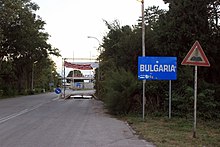Durankulak
| Durankulak (Дуранкулак) | ||||
|
||||
| Basic data | ||||
|---|---|---|---|---|
| State : |
|
|||
| Oblast : | Dobrich | |||
| Residents : | 478 (Sept. 13, 2005) | |||
| Coordinates : | 43 ° 42 ′ N , 28 ° 31 ′ E | |||
| Height : | 26 m | |||
| Postal code : | 9670 | |||
| Telephone code : | (+359) 05748 | |||
| License plate : | TX | |||
| administration | ||||
| Mayor : | Syumbjul Medarov | |||
Durankulak [ doˌrankoɫak ] ( bulg . Дуранкулак ) is a village in northeastern Bulgaria . It is located in Dobruja , in Dobrich Oblast and the municipality of Shabla .
geography

The village is located in the extreme northeast corner of Bulgaria, 2.5 km from the Black Sea and five kilometers from Romania . Near the village of picturesque and rich are Durankulak Lake (bulg Дуранкулашко езеро;. Area about 400 ha), the Orlowo Lake and Lake Shabla ; They are coastal lakes ( Liman ) with a large wetland area, a very important biotope, including the main wintering area for the red-necked goose .
Bulgarian-Romanian border crossing
Since the border between Bulgaria and Romania runs mainly along the Danube and the only bridge over the Danube is near Russe , there were only a few border crossings before Bulgaria and Romania joined the EU. In addition to the Danube ferry between Vidin and Calafat and the Kardam border crossing , this was the Durankulak-Vama Veche border crossing , five kilometers from Durankulak. Since the Danube runs further north here, this border crossing was on dry ground (without a bridge or ferry).
history
Prehistory and early history
Prehistoric settlements have been found on the shores of the lakes and on the large island in Lake Durankulak.
The first settlement is dated to the Hamangia culture (approx. 5400-4500 BC). One of the largest necropolises in Europe was found on the large island and in the Niwata area (Bulgarian: Нивата, German for pasture) 4500 to 5000 years older than the cemetery of Varna . Because of its age and importance, it is called "Bulgarian Troy ". Later settlements from other times and different cultures followed. The last settlement was Bulgarian and disappeared at the end of the 19th century. Interestingly, there was a Kapishte (Bulgarian капище - a sacred place of the South and West Slavs) in this settlement, the entrance of which was walled up, and there was a church nearby. Apparently the village had been Christianized . The excavations dragged on for a relatively long time, they are still carried out on a limited scale. A number of valuable evidence of ancient Bulgarians and older cultures have been found. The only cave sanctuary of the goddess Cybele in Europe is located on the large island in Lake Durankulak .
Recent history
Like most villages in Dobruja , this one was founded around 1800 - by resettlers from the region around the eastern Balkan Mountains (mainly from the area around Kotel , a little less from Eastern Thrace , the European part of today's Turkey, with the city of Edirne ). The name Durankulak is Turkish, although Turks never lived in the village itself. It comes from the shape of the lake and is freely translated as "water ear". The local population otherwise called the lakes Gjola (Bulgarian гьола) or simply swamp (Bulgarian блатото). After the area finally belonged to Bulgaria from 1940 (it was previously Romanian at times), the village Blatnitsa (Bulgarian Блатница; stem: swamp) was named. The name stayed until the 1950s.
The most famous recent event in the history of the village is the uprising of Durankulak (bulg. Дуранкулашкият бунт) on June 1, 1900 against the government of Wasil Radoslavov (bulg. Васил Радославов), which introduced a tax ( tithe ). The farmers of the surrounding villages gathered near Durankulak at that time. The exact course is not known. A farmer had probably shot an officer. A cavalry squad then restored order. None of the 40 or so dead were from Durankulak. The statue of the "Waiting Woman" is dedicated to the Durankulak uprising (in the cemetery, west of the village).
After the Balkan Wars (1913) Durankulak fell to Romania. With the signing of the Craiova Treaty on September 7, 1940, Durankulak and the entire southern Dobruja fell back to Bulgaria. According to the contract, almost all Bulgarians (around 50,000) were resettled from North Dobruja. These resettlers arrived in South Dobruja with almost nothing - just their flocks and what they could carry. A large group of these resettlers settled in Durankulak. They and their descendants now make up about half of the village population of Durankulak. Most of the resettlers in Durankulak came from Nuntași in today's Constanța district .
Culture and sights
In Durankulak there is the church Sweti Archangel Michail (bulg. Свети Архангел Михаил; Archangel Michael ), a Tschitalischte (a kind of culture house), a museum collection, a picture gallery and a larger library.
Every year in August the "Week of the Sea" is held. The annual meeting of all villagers, family members and former villagers (Bulgarian Събор / Sabor, German: meeting) takes place annually on June 1st.
Personalities
- Ivan Natschew (* 1968), political scientist
- Georgi Zwetkow, political scientist
- Petar Petrow, Vice Admiral and Politician
- Rumen Jankow, geographer
Individual evidence
- ↑ Christina Näslund, Neolithic Settlements on Balkan, a comparative Study between Durankulak and Sitagroi. Master's thesis, Uppsala University
- ↑ Biography and list of publications (Bulgarian) on the website of the New Bulgarian University



